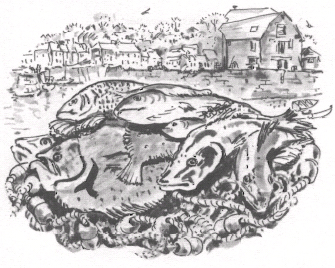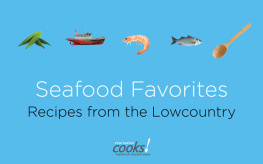PENGUIN COOKERY LIBRARY
ENGLISH SEAFOOD COOKERY
Rick Stein was born in 1947 on a farm near Chipping Norton in Oxfordshire, and was educated at Uppingham School. Having worked as a chef at the Great Western Royal Hotel at Paddington, he spent several years travelling and held a variety of occupations, from being a television studio assistant in Sydney to a deckhand on a German cargo ship. He returned to read English at New College, Oxford, but went on to find a practical outlet for his enthusiasm for the splendours of seafood when he and his wife Jill opened the Sea Food Restaurant in Padstow, Cornwall, in 1975. Since then the business has grown from one small harbour-side bistro into a number of establishments with a genuinely international reputation and clientele.
Over the last twenty-five years Rick Stein has become the household name in the UK for fish cookery, having written a number of popular cookbooks which have won numerous awards. English Seafood Cookery won the 1989 Glenfiddich Award for the Food Book of the Year. Rick Steins Taste of the Sea won the 1995 Andr Simon Memorial Fund Book Award and the Good Food Award in 1996. He has made a number of television series and films which have also proved to be highly successful. Rick Steins Taste of the Sea won the 1996 Glenfiddich Award for Best Television Programme of the Year.
The Steins live at Trevone Bay near Padstow with their three sons and their Jack Russell, Chalky, who has become something of a star in his owners television appearances. Ricks passion continues to be for fresh, simply cooked fish and, as well practising his craft, he now hopes to spend more time supporting the causes of fishermen in the South West.
RICK STEIN
ENGLISH SEAFOOD COOKERY


PENGUIN BOOKS
PENGUIN BOOKS
Published by the Penguin Group
Penguin Books Ltd, 80 Strand, London WC2R 0RL, England
Penguin Putnam Inc., 375 Hudson Street, New York, New York 10014, USA
Penguin Books Australia Ltd, 250 Camberwell Road, Camberwell, Victoria 3124, Australia
Penguin Books Canada Ltd, 10 Alcorn Avenue, Toronto, Ontario, Canada M4V 3B2
Penguin Books India (P) Ltd, 11 Community Centre, Panchsheel Park, New Delhi 110 017, India
Penguin Books (NZ) Ltd, Cnr Rosedale and Airborne Roads, Albany, Auckland, New Zealand
Penguin Books (South Africa) (Pty) Ltd, 24 Sturdee Avenue, Rosebank 2196, South Africa
Penguin Books Ltd, Registered Offices: 80 Strand, London WC2R 0RL, England
www.penguin.com
First published 1988
Copyright Richard Stein, 1988
Illustrations Katinka Kew, 1988
All rights reserved
Except in the United States of America, this book is sold subject to the condition that it shall not, by way of trade or otherwise, be lent, re-sold, hired out, or otherwise circulated without the publishers prior consent in any form of binding or cover other than that in which it is published and without a similar condition including this condition being imposed on the subsequent purchaser
ISBN: 978-0-14-195746-3
CONTENTS
6 BASIC PREPARATIONS
(Stocks, Sauces, Butters, Dressings, Batters, Pastry and Salting)
S o many cookery books appear every year that one must explain the reason for writing yet another. This book is about the seafood I cook at my restaurant in Padstow. It doesnt aim to be comprehensive in its coverage of the cookery of fish and shellfish in Great Britain, and although it is called English Seafood Cookery, you wont find many traditional recipes in it. This is largely because there arent many. Some English dishes like fish and chips, stargazey pie or potted shrimps are well-known and good; but one soon begins to run out of material. To fill a book with recipes with an English flavour, one has to look elsewhere than to traditional English cookery, and that is where the recipes from my restaurant come in.
The Seafood Restaurant, which I run, is in the small fishing port of Padstow on the North Cornish coast. My wife Jill and I started it twelve years ago in this part of England long dismissed as a gastronomic desert; but after a dozen years if you were to tell me that the English are not interested in seafood, I would say that was rubbish. The publics appreciation of good food has progressed incredibly fast in that period.
Just to give you an idea, twelve years ago we were selling sea bass as the unnamed fish in fish and chips; now we cannot buy enough of it to satisfy the demand, and it certainly doesnt go into fish and chips any more. A popular main course that we sold then called Seafood Thermidor used to be described as follows: Lobster, crab and prawns with sole and other white fish in a white wine sauce with cheese, mustard and mushrooms. The other white fish was monkfish, which now features as a main course in its own right and sells very well.
There are virtually no fish we cannot interest our customers in now, even conger eel and shark; but how many recipes in our traditional cuisine can be found for the unusual varieties? This book covers almost every type of fish, crustacean and mollusc available around our shores and presents them in a way I hope you will find inspiring. Thats why its English Seafood Cookery the cooking by English chefs of fish from English coastal waters in an English fishing port for English people. I may borrow from France, Italy, and even China, India and Japan, but everything is finely filtered by the place where I work and the people I cook for. We may not have much culinary heritage to refer to in the cooking of seafood, but its time we showed the French and Italians we can do it too!
THE SALE OF FISH TODAY
Now that I have begun on an optimistic note about the growing interest in fish, let me temper this with a couple of observations I made recently.
The supermarket in Wadebridge, six miles from the coast here in Cornwall, sells two types of fish: frozen plaice fillets and frozen cod fillets. Last time I was in Brittany, I went to a supermarket eight miles from the coast, between Dinard and Dinan. In addition to every type of wet fish commonly available, including John Dory and slip soles, arranged in glistening mounds with that natural flair for presentation of food for sale so obvious everywhere in France, they had live scallops, two sizes of fresh langoustine, squid, shrimps, palordes and praires, baskets of oysters and mussels, and a vivarium filled with lobsters, crawfish, crabs and spider crab.
If you think it unfair to contrast an area of France known for its seafood and an area of England which isnt (but should be and will be!), dont imagine that the situation is much better in London. Last March, I went into a large supermarket in the Kings Road to see what fish they had. This shop was selling fresh root turmeric, tamarind, fresh basil, tarragon, lambs lettuce, radicchio, fris a first-class selection of fresh produce, even in March. Yet this shop had just four types of fresh fish for sale no shellfish, not even a mussel.
We must make more demands on our suppliers. That supermarket could sell much more. The fish shop here in Padstow, run by the Cornish Fishermens Cooperative, sells magnificent fish, and not just cod and plaice, but John Dory, red mullet, monkfish, dogfish, conger eel. I think the speed with which they turn it all over astonishes them, but the public are confident because they know it comes straight off the boats.
This is not just the case in a fishing port. I talk to customers in our restaurant from all over Great Britain and find that anyone with a serious interest in cooking always knows somewhere now that sells good fresh fish. You have to be in the know, and generally its still frozen plaice fillets everywhere else. But I sense a change; and its about time too.
















